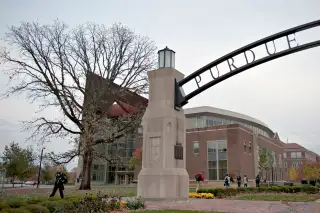A Hot New Way to Pay for College Makes Parents Suspicious

A new option for paying for college is dogged by suspicion and controversy, the American Enterprise Institute has found.
For more than 60 years, economists have been trying to persuade colleges, investors and students to try out “income share agreements” – allowing students to get free tuition in return for paying whoever fronted their tuition - a government agency, their college, or a private investor - a percentage of their income after they graduate.
It’s a concept beloved by economists, who note that Nobel Prize winner Milton Friedman proposed it in 1955. (He called the idea "human capital investments.")
But they are only now taking off. A few coding academies started offering the option in the last few years. This fall, Purdue University launched the first significant ISA experiment with “Back a Boiler,” which students can use to raise, say, $10,000 for tuition, in return for 2% to 5% of their salary for up to 10 years. (Engineers pay a smaller percentage for a shorter time than, say, social workers.) Only about 150 Boilermakers have agreed to the deal so far, a number Purdue Foundation spokeswoman Cynthia Sequin says the school is hoping to increase over the next year.
In focus group interviews of 10 parents and 10 students each in Columbus, OH, and Boston, the AEI found that there may be good reasons that the idea has gained so little traction so far: “It’s not as intuitive as Milton Friedman thought,” says Alexander Holt, who wrote the AEI report.
In fact, he found that many people were initially suspicious of the idea because they hadn’t heard of it.
After it was explained, opinions were divided.
Many, mostly students, loved the idea because it meant that if they ended up unemployed or with a low-paying job, they wouldn’t go broke trying to repay a student loan, Holt found. “This is a great safety net,” one student concluded. (While student loans charge interest that builds up every month, ISAs are only a claim on a small percentage of a student's earnings over a set period of time. So after the student makes the agreed-upon number of income-based payments, there is no further obligation - even if the amount paid is far less than the funding originally provided.)
The parents in the focus group, however, generally seemed to have a more difficult time understanding how ISAs differ from student loans, Holt said. Some parents resisted the idea because the students who ended up earning a lot of money would pay more than they might with a loan. One called the possibility of higher payments for higher earners “un-American.”
The focus groups showed how unrealistic supposedly elegant economic theories can be, Holt noted. There were at least three important conflicts between economists’ ideas about ISAs and what people in the focus groups said they would agree to:
- Length of payments: In theory, ISAs work best if the students pay a very small percentage over several decades – say 30 years, Holt notes. That way, the payments are the least onerous for students, and investors have the best likelihood of collecting a good return on their money. But the focus groups overwhelmingly wanted the shortest payoff period possible, even when they were told that would mean they’d have to pay a much higher percentage of their income. The students’ opposition to long contracts made sense since most of them were only about 20 years old, Holt observed, adding it’s hard, psychologically, to agree to a contract for longer than you’ve been alive.
- Cap on payments: In theory, ISAs are like a share of “stock” in someone. So the investors should benefit if the person they invested in gets rich. But most (though not all) of the focus group members objected to the possibility that they might pay more on an ISA than they would on a traditional loan. They generally wanted some sort of cap on their monthly or total payments. Of course, if investors limited their possible profits, they’d have to charge a higher share of income to make sure they recouped their costs, Holt said.
- Ability to pre-pay: Many members of the focus group wanted an ability to buy out of the contract if they came into money early, a right that is generally only available in loans. “We’ve done a very good job of getting people to be debt-averse. A certain number of people say they don’t want to feel trapped in this and want to be able to get out faster,” Holt said. But it would be very hard to design an ISA that would be attractive to investors if students could buy out early, since the wealthiest students would be most likely to take the early payoff, leaving only low-earning graduates in investors' portfolios.
Holt said that, overall, most of the focus group members were intrigued when they learned about ISAs.
But the general tenor of the focus groups' comments made it clear that “there are things about the product that are not likable,” Holt said. Many students would likely be leery unless colleges or investors figure out a way to address concerns about high payments, for example, he said.
Even if they did, Holt added, “there are some people for whom this product just isn’t for them.”